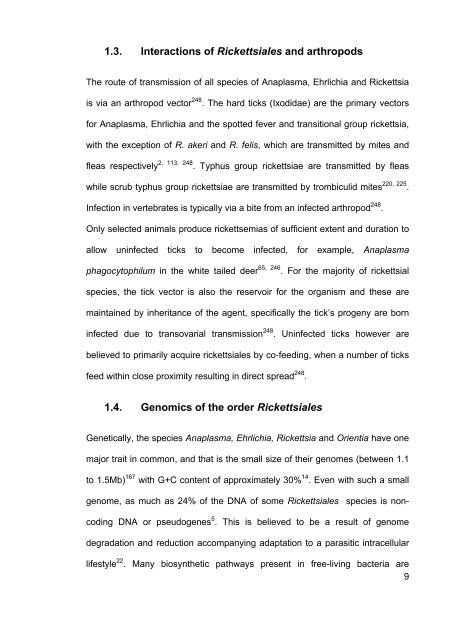Rickettsiales and rickettsial diseases in Australia - Murdoch ...
Rickettsiales and rickettsial diseases in Australia - Murdoch ...
Rickettsiales and rickettsial diseases in Australia - Murdoch ...
You also want an ePaper? Increase the reach of your titles
YUMPU automatically turns print PDFs into web optimized ePapers that Google loves.
1.3. Interactions of <strong>Rickettsiales</strong> <strong>and</strong> arthropods<br />
The route of transmission of all species of Anaplasma, Ehrlichia <strong>and</strong> Rickettsia<br />
is via an arthropod vector 248 . The hard ticks (Ixodidae) are the primary vectors<br />
for Anaplasma, Ehrlichia <strong>and</strong> the spotted fever <strong>and</strong> transitional group rickettsia,<br />
with the exception of R. akeri <strong>and</strong> R. felis, which are transmitted by mites <strong>and</strong><br />
fleas respectively 2, 113, 248 . Typhus group rickettsiae are transmitted by fleas<br />
while scrub typhus group rickettsiae are transmitted by trombiculid mites 220, 225 .<br />
Infection <strong>in</strong> vertebrates is typically via a bite from an <strong>in</strong>fected arthropod 248 .<br />
Only selected animals produce rickettsemias of sufficient extent <strong>and</strong> duration to<br />
allow un<strong>in</strong>fected ticks to become <strong>in</strong>fected, for example, Anaplasma<br />
phagocytophilum <strong>in</strong> the white tailed deer 65, 246 . For the majority of <strong>rickettsial</strong><br />
species, the tick vector is also the reservoir for the organism <strong>and</strong> these are<br />
ma<strong>in</strong>ta<strong>in</strong>ed by <strong>in</strong>heritance of the agent, specifically the tick’s progeny are born<br />
<strong>in</strong>fected due to transovarial transmission 248 . Un<strong>in</strong>fected ticks however are<br />
believed to primarily acquire <strong>rickettsial</strong>es by co‐feed<strong>in</strong>g, when a number of ticks<br />
feed with<strong>in</strong> close proximity result<strong>in</strong>g <strong>in</strong> direct spread 248 .<br />
1.4. Genomics of the order <strong>Rickettsiales</strong><br />
Genetically, the species Anaplasma, Ehrlichia, Rickettsia <strong>and</strong> Orientia have one<br />
major trait <strong>in</strong> common, <strong>and</strong> that is the small size of their genomes (between 1.1<br />
to 1.5Mb) 167 with G+C content of approximately 30% 14 . Even with such a small<br />
genome, as much as 24% of the DNA of some <strong>Rickettsiales</strong> species is non-<br />
cod<strong>in</strong>g DNA or pseudogenes 5 . This is believed to be a result of genome<br />
degradation <strong>and</strong> reduction accompany<strong>in</strong>g adaptation to a parasitic <strong>in</strong>tracellular<br />
lifestyle<br />
9<br />
22 . Many biosynthetic pathways present <strong>in</strong> free-liv<strong>in</strong>g bacteria are
















